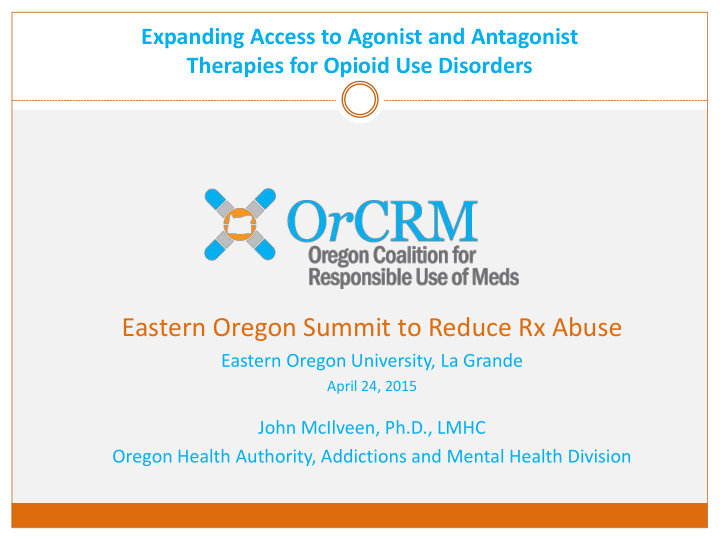



Expanding Access to Agonist and Antagonist Therapies for Opioid Use Disorders Eastern Oregon Summit to Reduce Rx Abuse Eastern Oregon University, La Grande April 24, 2015 John McIlveen, Ph.D., LMHC Oregon Health Authority, Addictions and Mental Health Division
Addiction as a Chronic Medical Condition • Genetic Heritability – twin studies • Hypertension – 25-50% • Diabetes – Type 1: 30-55%; Type 2: 80% • Asthma – 36-70% • Heroin – 34% (males) • Voluntary Choice – shaped by personality and environment • Physiology – neurological adaptations • Treatment • Medications – effectiveness and compliance • Behavioral interventions • Addiction or Dependence? Both? • DSM V Changes – Tolerance and Withdrawal • Not used as criteria for opioid dependence when taken as prescribed
Opioid Addiction: Facts • Rise of Heroin Use • 2009 - estimated 180,000 new users • 2010 - 12 million Americans/using prescription pain medications for non-medical purposes without prescription • 2010 - 2 million people/abusing prescription pain medication for the first time within the previous 12 month period • Drug overdose deaths surpass motor vehicle accident fatalities in over half of US states in 2013
Medications for the Treatment of Opioid Dependence • Methadone • “full agonist” (fully binding to mu receptors/blocks cravings, withdrawal symptoms, long acting • In the US, only dispensed for addiction treatment at an opioid treatment program (OTP) • 8,200 approximate methadone clients in Oregon (Q4 2014) • Combined with appropriate therapeutic structure most evidenced based treatment for opioid dependence • Reduced societal and medical costs, increased quality of life (employment, housing, criminal justice) • Disadvantages – location of treatment providers
Medications for the Treatment of Opioid Dependence • Buprenorphine • Subutex, Suboxone • Partial mu agonist (“partially binding”, prescribed and dispensed) • Advantages – greater flexibility, treatment integration with existing behavioral health system • Methadone v. Buprenorphine – different patients, different needs • Naltrexone • Full “antagonist”, must be abstinent for period of time before induction, shown effectiveness in certain populations, more to come • Drug Addiction Treatment Act of 2000 (DATA 2000) • Expands number of available treatment slots, increasing access, especially in rural areas • Monitored and regulated by the DEA • 361 registrants in Oregon (77 w/100, 280 w/30)
Recommend
More recommend